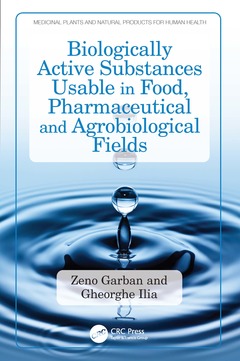Biologically Active Substances Usable in Food, Pharmaceutical and Agrobiological Fields Medicinal Plants and Natural Products for Human Health Series
Auteurs : Garban Zeno, Ilia Gheorghe

This concise text on biologically active substances of the food, pharmaceutical and agricultural industries presents data on natural compounds of vegetable and animal origin. Various nutrients in food, phytochemicals and zoochemicals are discussed, including their uses for prophylactic, metaphylactic and therapeutic purposes in personalized medicine. Along with these compounds, prebiotics isolated by biotechnological methods from plant tissues are reviewed, with the aim of obtaining compounds with an oligoglucide structure. Metabolism of nutrients and the biodegradation of xenobiotics are hot topics and access routes into the human body for the various biologically active substances are covered.
Features:
- Biologically active substances and related chemistry, biochemistry and agrochemistry data are rigorously discussed
- Data regarding natural compounds of vegetable origin detected from plants present in the spontaneous flora and plants obtained in agricultural crops (medicinal plants, aromatic plants and more) are presented
- Discusses the natural compounds of animal origin detected in the organisms of some terrestrial and aquatic animals
- Covers prebiotics isolated by technological and biotechnological methods from plant tissues, with the aim of obtaining compounds with oligoglucide structure
- Broad audience including all those in biochemistry, the food and pharmaceutical industries and agricultural fields
1. BIOLOGICALLY ACTIVE SUBSTANCES: CONCEPTUAL AND APPLICATIVE ASPECTS
Zeno Garban, Gheorghe Ilia
1.2. Characteristics of the chemical composition of the living organisms
1.2.1. Basic concepts
1.2.2. Bioconstituents, nutrients and chemical xenobiotics
1.3. Metabolisation of nutrients
1.3.1. Basic concepts
1.3.2. Phases and metabolization pathways
1.4. Biotransformation of chemical xenobiotics
1.4.1. Basic concepts
1.4.2. Phases and pathways of biotransformation
1.5. Metabolsation and biotransformation: Similitudes and discrepancies
1.6. Apparata and systems
1.7. Admission of biologically active substances in the body
1.7.1. Basic concepts
1.7.2. Gastrointestinal route
1.7.3. Pulmonary route
1.7.4. Cutaneous route
1.8. Barriers in biochemistry
1.8.1. Tissue barriers of the body
1.8.2. Membrane barriers of cells
1.9. Biomarkers in the investigation of biologically active substances
1.9.1. Types of biomarkers
1.9.2. Applications of biomarkers
1.10. Biologically active substances in ethnobiology - overview
References
2. NATURAL COMPOUNDS OF PLANT ORIGIN
Zeno Garban
2.1. Introduction
2.2. Chemical composition and natural distribution
2.3. Classification and nomenclature
2.4. Phytochemicals classes
2.4.1. Introductory exposure
2.4.2. Organic acids
2.4.3. Alkaloids
2.4.4. Phytoncides
2.4.5. Heterosides
2.4.6. Natural pigments
2.4.7. Tannins
2.4.8. Essential oils
References
3. NATURAL COMPOUNDS OF ANIMAL ORIGIN
Zeno Garban
3.1. Introduction
3.2. Chemical composition and natural distribution
3.3. Zoochemicals present in various food groups
3.3.1. Zoochemicals from milk and dairy products
3.3.2. Zoochemicals from meat and viscera
3.3.3. Zoochemicals from eggs
3.3.4. Zoochemicals from bee products
3.4. Zoochemicals present in animal tissues
References
4. PREBIOTICS
Zeno Garban
4.1. Introduction
4.2. Chemical composition and natural distribution
4.3. Classification and nomenclature
4.4. Prebiotics vs probiotics
4.5. Prebiotics and nutrition
4.6. Groups of prebiotic compounds
4.7. Prebiotics in foods and pharmaceutic products
4.8. Obtainment of prebiotic compounds - generalities
References
5. PLANT GROWTH BIOREGULATORS
Gheorghe Ilia
5.1. Introduction
5.2. Chemical composition and natural distribution
5.3. Brief history
5.4. Classes of chemical compounds
5.4.1. Auxins
5.4.2. Gibberellins
5.4.3. Cytokinins
5.4.4. Ethylene
5.4.5. Abscisic acid
5.4.6. Other compound as bioregulators
5.4.7. Natural and synthetized inhibiting substances
5.5. Bioregulators in food chemistry and nutrition
5.6. Growth regulators in agrobiology
5.6.1. General characteristics
5.6.2. Comparative effects
References
6. AD LIMINA INTERRELATIONS: ORGANISM-BIOLOGICALLY ACTIVE SUBSTANCES
Gheorghe Ilia, Zeno Garban
6.1. Introduction
6.2. Bioavailability
6.2.1. Basic concepts
6.2.2. Interdisciplinary characteristics
6.2.3. Conditioning of bioavailability
6.2.4. The relationship ligands-receptors and bioavailability
6.2.5. Bioavailability and biologically active substances
6.3. Chronobiochemistry
6.3.1. Basic concepts
6.3.2. Biorhythm conditioning
6.3.3. Periodicity of biorhythm
6.3.4. Biorhythm types and parameters
6.3.5. Autonomy and synchronization of biorhythms
6.3.6. Chronobiochemistry and phenology in the plant and animal kingdoms
6.4. Traceability of food and pharmaceutical products
6.4.1. Basic concepts
6.4.2. Traceability types
6.4.3. Systems of products identification
6.4.4. Traceability of biologically active substances
References
Zeno Garban – Ph.D., consulting professor of Biochemistry and Molecular biology, senior researcher, currently corresponding member of the Romanian Academy. He is member of some national and international scientific associations as well as of the editorial boards of some journals.
His educational background includes engineering studies at the University of “Life Sciences” Timişoara - Faculty of Agronomy, followed by the graduation of chemistry studies at the “Babeş-Bolyai” University Cluj-Napoca - Faculty of Chemistry. Afterwards, he defended his doctoral thesis and obtained the Ph.D. degree in chemistry (biochemistry).
Prof. Garban has an impressive research activity encompassing a broad spectrum of domains starting with comparative animal physiology (focusing on blood circulation – lactopoiesis, electrophoretic studies); neuroendocrine interrelationships in animal vasectomy: ethanol in teratology (on animal models) etc. He conducted studies in biochemistry and molecular biology, on specific interactions of DNA with various substances (metal ions, cytostatic drugs - in vitro and in vivo); the metabolization of nutrients and biotransformation of chemical xenobiotics of nutritional and pharmaceutical interest; the role of chemical xenobiotics in nutrition and pathobiochemistry. Professor Garban was doctoral advisor in the domain of chemistry (biochemistry) at the Polytechnic University of Timisoara.
His scientific activity was focused on the domains of food science, approaching the complex problems of metallomics and proteomics. The interdisciplinary character has been put into evidence both in the published articles and in books and treatises.
These achievements resulted in an intense publishing activity with over 380 scientific papers in the country and abroad, 32 books (28 as single author); chapters in books published by Pergamon Press-Oxford (1984), Libbey-London (1997), Wiley-VCH-Weinheim (2004). His most important works are re
Date de parution : 06-2024
15.6x23.4 cm



